ChatGPT as a Digital Tool in the Transformation of Digital Teaching Competence: A Systematic Review
Abstract
1. Introduction
2. Objectives
3. Methodology
3.1. Search Strategy
3.2. Inclusion and Exclusion Criteria
- Scientific articles published between 2022 and 2024.
- Articles written in English or Spanish.
- Papers in peer-reviewed scientific article format.
- Research specifically focused on the topic of study.
- Descriptive, predictive, and correlation studies.
- Scientific articles outside the specified range of years (2022–2024).
- Articles published in languages other than English or Spanish.
- Other studies (conference proceedings, book chapters, dissertations...).
- Research that does not focus on the specific field of study.
- Papers that are systematic reviews of the literature.
3.3. Assessment of the Methodological Quality of the Scientific Articles
3.4. Selection of the Scientific Articles
4. Results
- Red cluster: Evaluation and processes in the Digital Teacher Transformation.
- 2.
- Blue cluster: Perceptions and impact of ChatGPT integration in education.
- 3.
- Green cluster: Practical recommendations for the use of artificial intelligence.
5. Discussions
- Improve teacher training in DC through ChatGPT: It is crucial to establish ongoing training programmes that strengthen TDC, with a focus on the use of tools such as ChatGPT to optimise lesson design and classroom interaction. These programmes should focus on the practical use of ChatGPT as a digital assistant in lesson planning, assessment and feedback, thus promoting greater efficiency and personalisation of learning. Training should include the development of skills to manage human–machine collaboration effectively and ethically [16].
- Developing new pedagogical models that integrate ChatGPT as a supplementary tool: It is recommended that pedagogical models be designed that include ChatGPT as a supplementary support, rather than a replacement for traditional methodologies [64]. These models should promote personalised teaching and active learning, where AI facilitates access to resources, the analysis of educational data, and support for individual student needs. Integration must be balanced with direct instruction to ensure that critical skills such as analytical thinking and problem solving are maintained and reinforced [41]. The use of AI is also transforming the educational landscape by offering immersive, personalised, and tailored learning experiences. This approach can be integrated with AI to further personalise teaching and learning, as AI can analyse interaction data and adjust content according to the individual needs of each learner, optimising the educational process [65].
- Implement ethical and regulatory oversight: As ChatGPT becomes more integrated into educational processes, regulatory and ethical frameworks need to be put in place to ensure responsible use. This includes clear policies on data privacy, academic integrity, and the safety in the use of AI tools, ensuring that teachers are trained in the safe and ethical use of these technologies in the classroom [14].
- Investigate the integration of ChatGPT in the development of TDC: It is essential that future research explores how the incorporation of ChatGPT into teaching practice can improve TDC and their adaptation to digital educational environments. Studies should focus on optimising the relationship between teachers and AI technologies, assessing their impact on the quality of the educational process and on the development of skills such as critical digital literacy [6]. These studies should also investigate how AI can diversify assessment methods and improve learning outcomes [41]. On the other hand, the environmental impact is very important to investigate. In this regard, Nishant et al. [66] argued that AI has the potential to reduce energy and resource intensity by facilitating more effective environmental governance, which is particularly relevant in the integration of sustainable digital tools within education. In this context, Aggarwal [67] proposes that combining sustainable development initiatives with AI tools in education can foster a more efficient approach, achieving reduced resource use and promoting a positive environmental impact.
6. Conclusions
6.1. Limitations
6.2. Implications for Theory and Practice
6.3. Implications for Theory and Practice
Author Contributions
Funding
Institutional Review Board Statement
Informed Consent Statement
Data Availability Statement
Conflicts of Interest
References
- Ferrari, A. DIGCOMP: A Framework for Developing and Understanding Digital Competence in Europe; Joint Research Centre of the European Commission: Luxembourg, 2013. [Google Scholar]
- López Bueno, H.; Val, S.; Gaeta González, M.L. Importancia de la Digitalización Docente para una Educación Inclusiva, Crítica y Equitativa. Rev. Int. Educ. Para La Justicia Soc. 2023, 12, 211–227. [Google Scholar] [CrossRef]
- Moreno-Guerrero, A.J.; Marín-Marín, J.A.; Parra-González, M.E.; López-Belmonte, J. Computer in education in the 21st century. A scientific mapping of the literature in Web of Science. Campus Virtuales 2022, 11, 201–223. [Google Scholar] [CrossRef]
- Al-Hattami, H.M. Understanding perceptions of academics toward technology acceptance in accounting education. Heliyon 2023, 9, e13141. [Google Scholar] [CrossRef]
- Comisión Europea. DigCompEdu: Marco Europeo de Competencia Digital para Educadores; Oficina de Publicaciones de la Unión Europea: Luxembourg, 2017. [Google Scholar]
- Bacalja, A.; Aguilera, E.; Castrillón-Ángel, E. Critical digital literacy. In The Handbook of Critical Literacies; Routledge: London, UK, 2021; pp. 373–380. [Google Scholar] [CrossRef]
- Escudero, V.G.; Gutiérrez, R.C.; Somoza, J.A. Análisis de la autopercepción sobre el nivel de competencia digital docente en la formación inicial de maestros/as. Rev. Electrónica Interuniv. Form. Profr. 2019, 22, 193–218. [Google Scholar]
- Quiroz, J.E.S.; Rodríguez, M.U.; Cantabrana, J.L.L. Competencia digital docente en estudiantes de último año de Pedagogía de Chile y Uruguay. Comun. Rev. Científica Comun. Y Educ. 2019, 61, 33–43. [Google Scholar]
- Cabero-Almenara, J.; Barroso-Osuna, J.; Palacios-Rodríguez, A. Estudio de la competencia digital docente en Ciencias de la Salud. Su Relación Con Algunas variables. Educ. Médica 2021, 22, 94–98. [Google Scholar]
- Cabero-Almenara, J.; Palacios-Rodríguez, A. La formación docente en competencia digital: Una necesidad en la educación actual. Rev. Educ. A Distancia 2020, 20, 1–20. [Google Scholar] [CrossRef]
- Jiang, L.; Yu, N. Developing and validating a Teachers’ Digital Competence Model and Self-Assessment Instrument for secondary school teachers in China. Educ. Inf. Technol. 2024, 29, 8817–8842. [Google Scholar] [CrossRef]
- Roig-Vila, R.; Moreno-Isac, V. El pensamiento computacional en Educación. Análisis Bibliométrico Y temático. Rev. Educ. A Distancia (RED) 2020, 20, 1–24. [Google Scholar] [CrossRef]
- Ariza-Colpas, P.P.; Vicario, E.; Oviedo-Carrascal, A.I.; Trasero Aziz, S.; Piñeres-Melo, M.A.; Quintero-Linero, A.; Patara, F. Análisis de datos de reconocimiento de actividad humana: Historia, evoluciones y nuevas tendencias. Sensores 2022, 22, 3401. [Google Scholar] [CrossRef]
- ElSayary, A. An investigation of teachers’ perceptions of using ChatGPT as a supporting tool for teaching and learning in the digital era. J. Comput. Assist. Learn. 2023, 40, 931–945. [Google Scholar] [CrossRef]
- Sardi, J.; Darmansyah; Candra, O.; Yuliana, D.F.; Habibullah; Yanto, D.T.P.; Eliza, F. How Generative AI Influences Students’ Self-Regulated Learning and Critical Thinking Skills? A Systematic Review. Int. J. Eng. Pedagog. (Ijep) 2025, 15, 94–108. [Google Scholar] [CrossRef]
- Zhang, Y.; Zhou, Y. Research on ChatGPT’s Strategy to Promote the Digital Transformation of Education. In Proceedings of the 2023 26th ACIS International Winter Conference on Software Engineering, Artificial Intelligence, Networking and Parallel/Distributed Computing (SNPD-Winter), Taichung, Taiwan, 6–8 December 2023; pp. 28–31. [Google Scholar] [CrossRef]
- Zhai, X. ChatGPT: Artificial intelligence for education. Support. Instr. Decis. Mak. Potential Autom. Scored Three-Dimens. Assess. Syst. 2022, 1–18. [Google Scholar]
- Zawacki-Richter, O.; Marín, V.I.; Bond, M.; Gouverneur, F. Systematic review of research on artificial intelligence applications in higher education–where are the educators? Int. J. Educ. Technol. High. Educ. 2019, 16, 39. [Google Scholar] [CrossRef]
- Kasneci, E.; Sessler, K.; Küchemann, S.; Bannert, M.; Dementieva, D.; Fischer, F.; Gasser, U.; Groh, G.; Günnemann, S.; Hüllermeier, E.; et al. ChatGPT for good? On opportunities and challenges of large language models for education. Learn. Individ. Differ. 2023, 103, 102274. [Google Scholar] [CrossRef]
- Fan, P.; Gong, H.; Gong, X. The Application of ChatGPT in Translation Teaching: Changes, Challenges, and Responses. Int. J. Educ. Humanit. 2023, 11, 49–52. [Google Scholar] [CrossRef]
- Motlagh, N.; Khajavi, M.; Sharifi, A.; Ahmadi, M. The Impact of Artificial Intelligence on the Evolution of Digital Education: A Comparative Study of OpenAI Text Generation Tools including ChatGPT, Bing Chat, Bard, and Ernie. arXiv 2023, arXiv:2309.02029. [Google Scholar] [CrossRef]
- Lin, Y.; Long, Y.; Zhou, L. The Impact of ChatGPT on University Teacher-Student Interactions. Lect. Notes Educ. Psychol. Public Media 2023, 24, 197–204. [Google Scholar] [CrossRef]
- Yang, X.; Wang, Q.; Lyu, J. Assessing ChatGPT’s educational capabilities and application potential. ECNU Rev. Educ. 2023, 7, 699–713. [Google Scholar] [CrossRef]
- Kiryakova, G.; Angelova, N. ChatGPT A Challenging Tool for the University Professors in Their Teaching Practice. Educ. Sci. 2023, 13, 1056. [Google Scholar] [CrossRef]
- Jarrah, A.; Wardat, Y.; Fidalgo, P. Using ChatGPT in academic writing is (not) a form of plagiarism: What does the literature say? Online J. Commun. Media Technol. 2023, 13, e202346. [Google Scholar] [CrossRef]
- Shamsudin, N.; Aris, S. Perspectives of ChatGPT for Teachers Trainee Programs in Designing STEM Lessons. Int. J. Acad. Res. Progress. Educ. Dev. 2023, 12, 1696–1701. [Google Scholar] [CrossRef]
- Gallent-Torres, C.; Arenas Romero, B.; Vallespir Adillón, M.; Foltýnek, T. Inteligencia Artificial en educación: Entre riesgos y potencialidades. Práxis Educ. 2024, 19, 1–29. [Google Scholar] [CrossRef]
- Anguera, M.T. Revisitando las revisiones sistemáticas desde la perspectiva metodológica. RELIEVE 2021, 29, M4. [Google Scholar] [CrossRef]
- Farrokhnia, M.; Banihashem, S.; Noroozi, O.; Wals, A. A SWOT analysis of ChatGPT: Implications for educational practice and research. Innov. Educ. Teach. Int. 2023, 61, 460–474. [Google Scholar] [CrossRef]
- Mbwambo, N.; Kaaya, P. ChatGPT in Education: Applications, Concerns and Recommendations. J. ICT Syst. 2024, 2, 107–124. [Google Scholar] [CrossRef]
- Page, M.J.; McKenzie, J.E.; Bossuyt, P.M.; Boutron, I.; Hoffmann, T.C.; Mulrow, C.D.; Shamseer, L.; Tetzlaff, J.M.; Akl, E.A.; Brennan, S.E.; et al. The PRISMA 2020 statement: An updated guideline for reporting systematic reviews. Rev. Española Cardiol. 2021, 74, 790–799. [Google Scholar] [CrossRef]
- Linares-Espinós, E.; Hernández, V.; Domínguez-Escrig, J.L.; Fernández-Pello, S.; Hevia, V.; Mayor, J.; Padilla-Fernández, B.; Ribal, M.J. Metodología de una revisión sistemática. Actas Urológicas Españolas 2018, 42, 499–506. [Google Scholar] [CrossRef]
- Rahim, F.; Widodo, A. Computational mapping analysis of artificial intelligence in education publications: A bibliometric approach utilizing vosviewer. Momentum Phys. Educ. J. 2024, 8, 304–317. [Google Scholar] [CrossRef]
- Abnoulgid, F.; Aouhassi, S.; Mansouri, K.; Akef, F. Bibliometric Analysis of Publications: University 4.0 and Higher Education Quality (HEQ). In Proceedings of the 2024 4th International Conference on Innovative Research in Applied Science, Engineering and Technology (IRASET), Fez City, Morocco, 16–17 May 2024; pp. 1–10. [Google Scholar] [CrossRef]
- Aromataris, E.; Munn, Z. JBI Manual for Evidence Synthesis; Joanna Briggs Institute: Adelaide, Australia, 2020. [Google Scholar]
- Iqbal, N.; Ahmed, H.; Azhar, K. Exploring Teachers’ Attitudes towards Using Chat GPT. Glob. J. Manag. Adm. Sci. 2023, 3, 97–111. [Google Scholar] [CrossRef]
- Nguyen, T.T.H. EFL Teachers’ Perspectives toward the Use of ChatGPT in Writing Classes: A Case Study at Van Lang University. Int. J. Lang. Instr. 2023, 2, 1–47. [Google Scholar] [CrossRef]
- Ali, J.K.M.; Shamsan, M.A.A.; Hezam, T.A.; Mohammed, A.A.Q. Impact of ChatGPT on Learning Motivation: Teachers and Students’ Voices. J. Engl. Stud. Arab. Felix 2023, 2, 41–49. [Google Scholar] [CrossRef]
- Allehyani, S.H.; Algamd, M.A. Digital Competences: Early Childhood Teachers’Beliefs and Perceptions of ChatGPT Application in Teaching English as a Second Language (ESL). Int. J. Learn. Teach. Educ. Res. 2023, 22, 343–363. [Google Scholar] [CrossRef]
- Urazbayeva, G.; Kussainova, R.; Aibergen, A.; Kaliyeva, A.; Kantayeva, G. Innovation Off the Bat: Bridging the ChatGPT Gap in Digital Competence among English as a Foreign Language Teachers. Educ. Sci. 2024, 14, 946. [Google Scholar] [CrossRef]
- Firat, M. What ChatGPT means for universities: Perceptions of scholars and students. J. Appl. Learn. Teach. 2023, 6, 57–63. [Google Scholar] [CrossRef]
- Kaplan-Rakowski, R.; Grotewold, K.; Hartwick, P.; Papin, K. Generative AI and Teachers’ Perspectives on Its Implementation in Education. J. Interact. Learn. Res. 2023, 34, 313–338. [Google Scholar]
- Al-Mughairi, H.; Bhaskar, P. Exploring the factors affecting the adoption AI techniques in higher education: Insights from teachers’ perspectives on ChatGPT. J. Res. Innov. Teach. Learn. 2024. [Google Scholar] [CrossRef]
- Gladstone, R. Using ChatGPT in the Classroom: Opportunities, Limitations, and Ethical Considerations. Spicer Advent. Univ. Res. Artic. J. 2023, 2, 17–25. [Google Scholar] [CrossRef]
- Mondal, H.; Marndi, G.; Behera, J.; Mondal, S. ChatGPT for teachers: Practical examples for utilizing artificial intelligence for educational purposes. Indian J. Vasc. Endovasc. Surg. 2023, 10, 200–205. [Google Scholar] [CrossRef]
- Kayali, B.; Yavuz, M.; Balat, Ş.; Çalişan, M. Investigation of student experiences with ChatGPT-supported online learning applications in higher education. Australas. J. Educ. Technol. 2023, 39, 20–39. [Google Scholar] [CrossRef]
- Rahim, M.; Rahim, E.; Razawi, N.; Mohamed, N. Students’ Perception on the Use of ChatGPT as a Language Learning Tool. Idealogy J. 2023, 8, 70–78. [Google Scholar] [CrossRef]
- Bitzenbauer, P. ChatGPT in physics education: A pilot study on easy-to-implement activities. Contemp. Educ. Technol. 2023, 15, ep430. [Google Scholar] [CrossRef] [PubMed]
- Estrellado, C.; Millar, G. ChatGPT: Towards Educational Technology Micro-Level Framework. Int. J. Sci. Technol. Eng. Math. 2023, 3, 101–127. [Google Scholar] [CrossRef]
- Murgia, E.; Pera, M.; Landoni, M.; Huibers, T. Niños en ChatGPT Legibilidad en un contexto educativo: ¿mito u oportunidad? In Proceedings of the Adjunct Proceedings of the 31st ACM Conference on User Modeling, Adaptation and Personalization, Limassol, Cyprus, 26–30 June 2023. [Google Scholar] [CrossRef]
- Wardat, Y.; Tashtoush, M.; AlAli, R.; Jarrah, A. ChatGPT: A revolutionary tool for teaching and learning mathematics. Eurasia J. Math. Sci. Technol. Educ. 2023, 19, em2286. [Google Scholar] [CrossRef] [PubMed]
- Nguyen, T.C. University Teachers’ Perceptions of Using ChatGPT in Language Teaching and Assessment. Proc. AsiaCALL Int. Conf. 2024, 4, 116–128. [Google Scholar] [CrossRef]
- Araujo Inastrilla, C.F. Data Visualization in the Information Society. Semin. Med. Writ. Educ. 2023, 2, 25. [Google Scholar] [CrossRef]
- Nazaretsky, T.; Ariely, M.; Cukurova, M.; Alexandron, G. Teachers’ trust in AI-powered educational technology and a professional development program to improve it. Br. J. Educ. Technol. 2022, 53, 914–931. [Google Scholar] [CrossRef]
- Dai, W.; Lin, J.; Jin, H.; Li, T.; Tsai, Y.; Gašević, D.; Chen, G. Can Large Language Models Provide Feedback to Students? A Case Study on ChatGPT. In Proceedings of the 2023 IEEE International Conference on Advanced Learning Technologies (ICALT), Orem, UT, USA, 10–13 July 2023; pp. 323–325. [Google Scholar] [CrossRef]
- Wu, Y. Critical Thinking Pedagogics Design in an Era of ChatGPT and Other AI Tools—Shifting From Teaching “What” to Teaching “Why” and “How”. J. Educ. Dev. 2024, 8, 1. [Google Scholar] [CrossRef]
- Doshi, R.; Bajaj, S.; Krumholz, H. ChatGPT: Temptations of Progress. Am. J. Bioeth. 2023, 23, 6–8. [Google Scholar] [CrossRef]
- Rahman, M.; Watanobe, Y. ChatGPT for Education and Research: Opportunities, Threats, and Strategies. Appl. Sci. 2023, 13, 5783. [Google Scholar] [CrossRef]
- Pita Fernández, S.; Díaz, P. Investigación cuantitativa y cualitativa. Cad. Atención Primaria 2022, 9, 76–78. [Google Scholar]
- Rubio-Romero, J.; Perlado, M. The Whatsapp phenomenon in the context of personal communication: An approximation through the university youths. ICONO 2015, 15, 73–94. [Google Scholar]
- Siminto Lisnawati, S.; Muharam, S. Teacher Professionalism Development Strategy through ChatGPT Support in the Context of Education Management. J. Contemp. Adm. Manag. 2023, 1, 150–155. [Google Scholar] [CrossRef]
- Lo, C. What Is the Impact of ChatGPT on Education? A Rapid Review of the Literature. Educ. Sci. 2023, 13, 410. [Google Scholar] [CrossRef]
- An, Y.; Ouyang, W.; Zhu, F. ChatGPT in Higher Education: Design Teaching Model Involving ChatGPT. Lect. Notes Educ. Psychol. Public Media 2023, 24, 47–56. [Google Scholar] [CrossRef]
- Baskara, F. AI-Driven Dynamics: ChatGPT Transforming ELT Teacher-Student Interactions. Lensa Kaji. Kebahasaan Kesusastraan Dan Budaya 2023, 13, 261–275. [Google Scholar] [CrossRef]
- Fernández Cerero, J.; Fernández Batanero, J.M.; Montenegro-Rueda, M. Possibilities of Extended Reality in education. Interact. Learn. Environ. 2024, 33, 208–222. [Google Scholar] [CrossRef]
- Nishant, R.; Kennedy, M.; Corbett, J. Artificial intelligence for sustainability: Challenges, opportunities, and a research agenda. Int. J. Inf. Manag. 2020, 53, 102104. [Google Scholar] [CrossRef]
- Aggarwal, D. Green Education: A Sustainable Development Initiative with the Power of Artificial Intelligence (AI). J. Image Process. Intell. Remote Sens. 2023, 3, 39–44. [Google Scholar] [CrossRef]
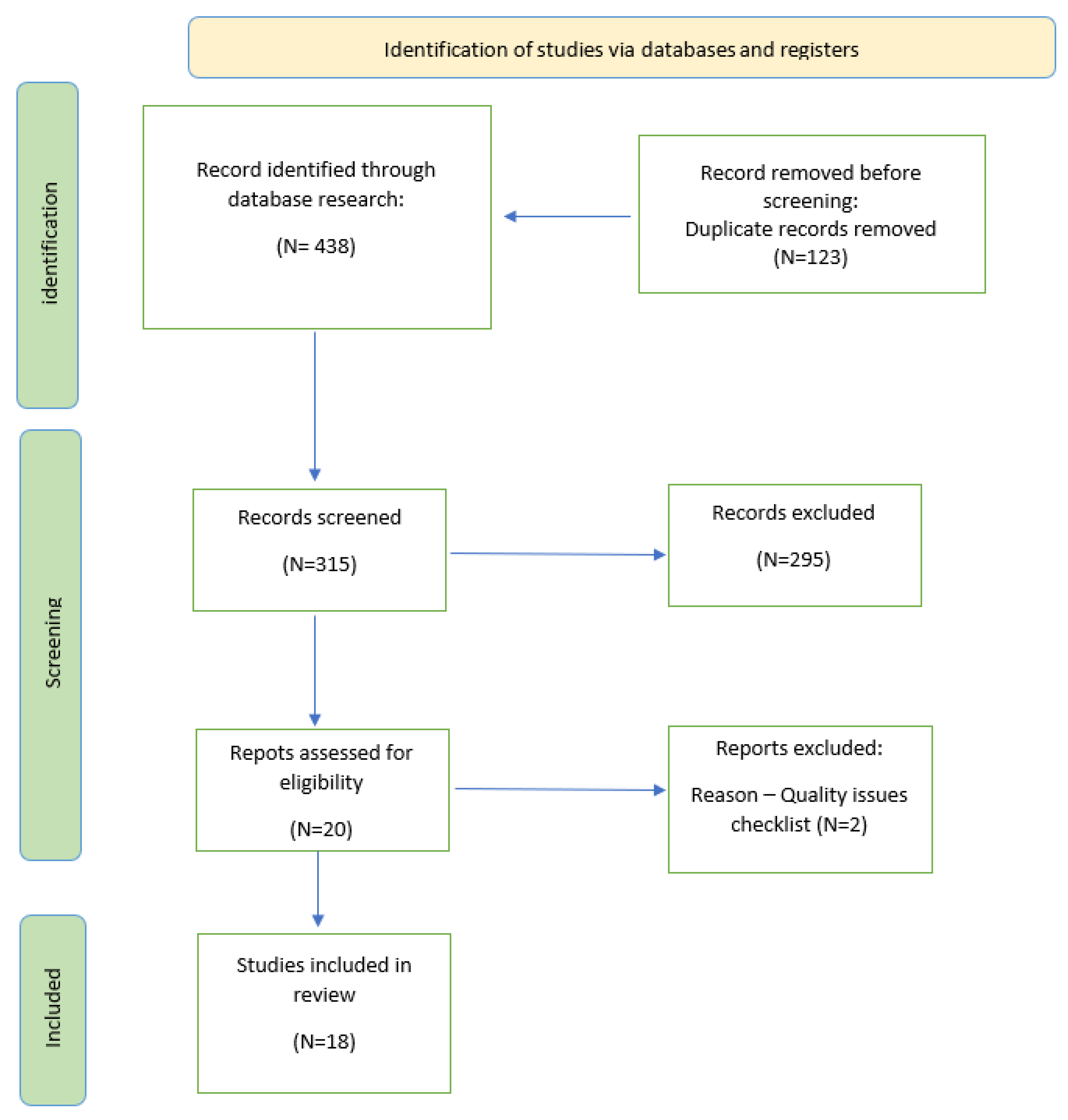
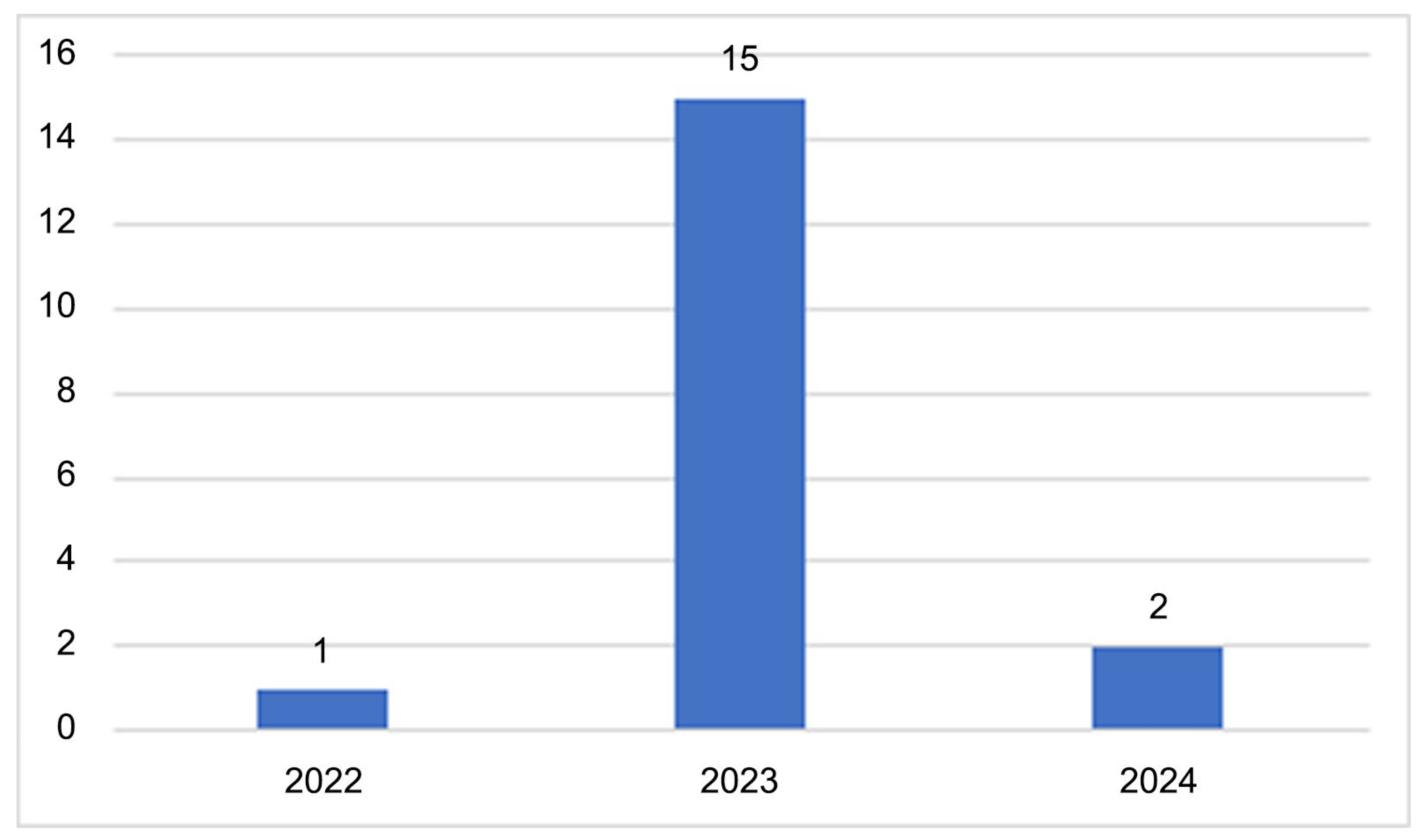
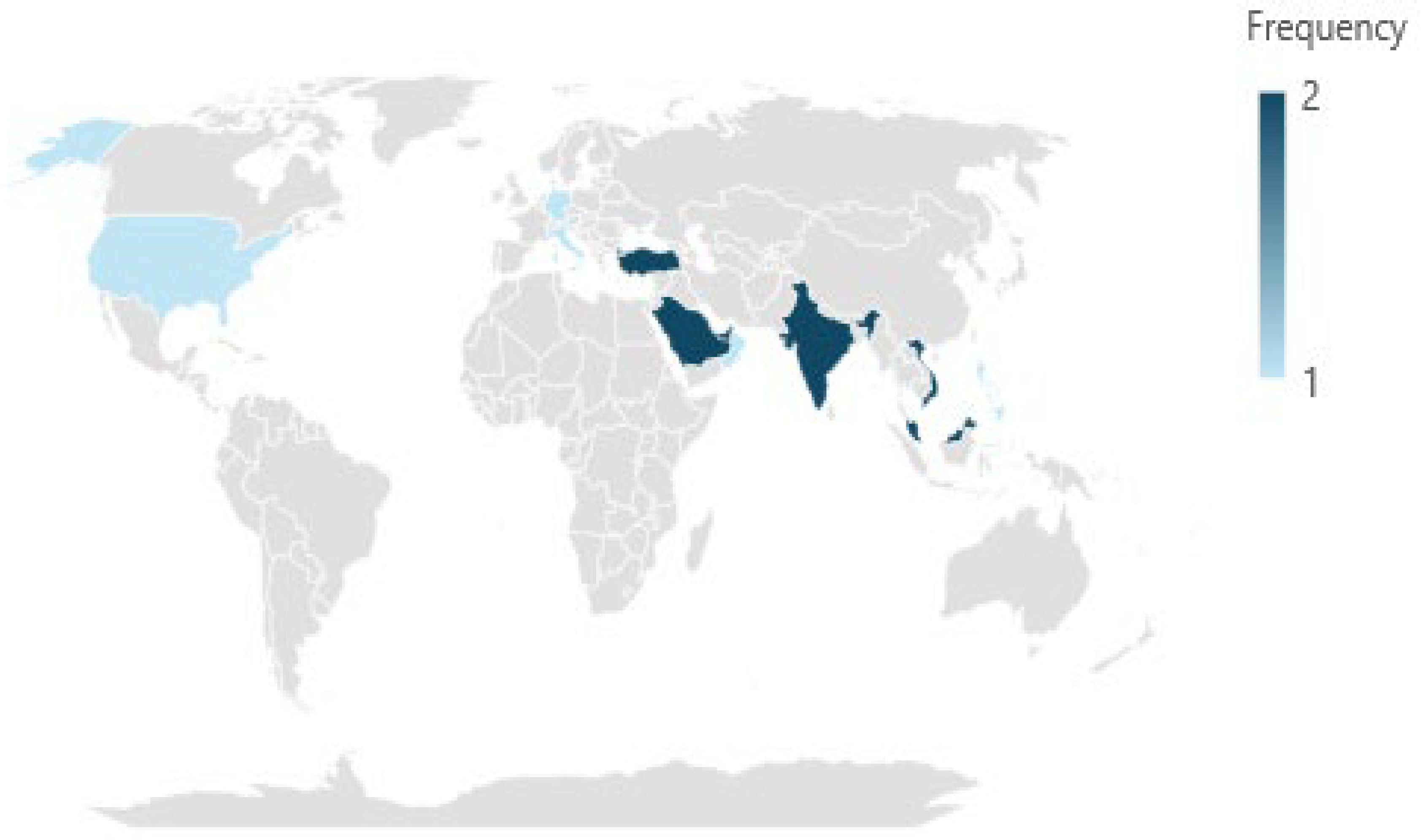
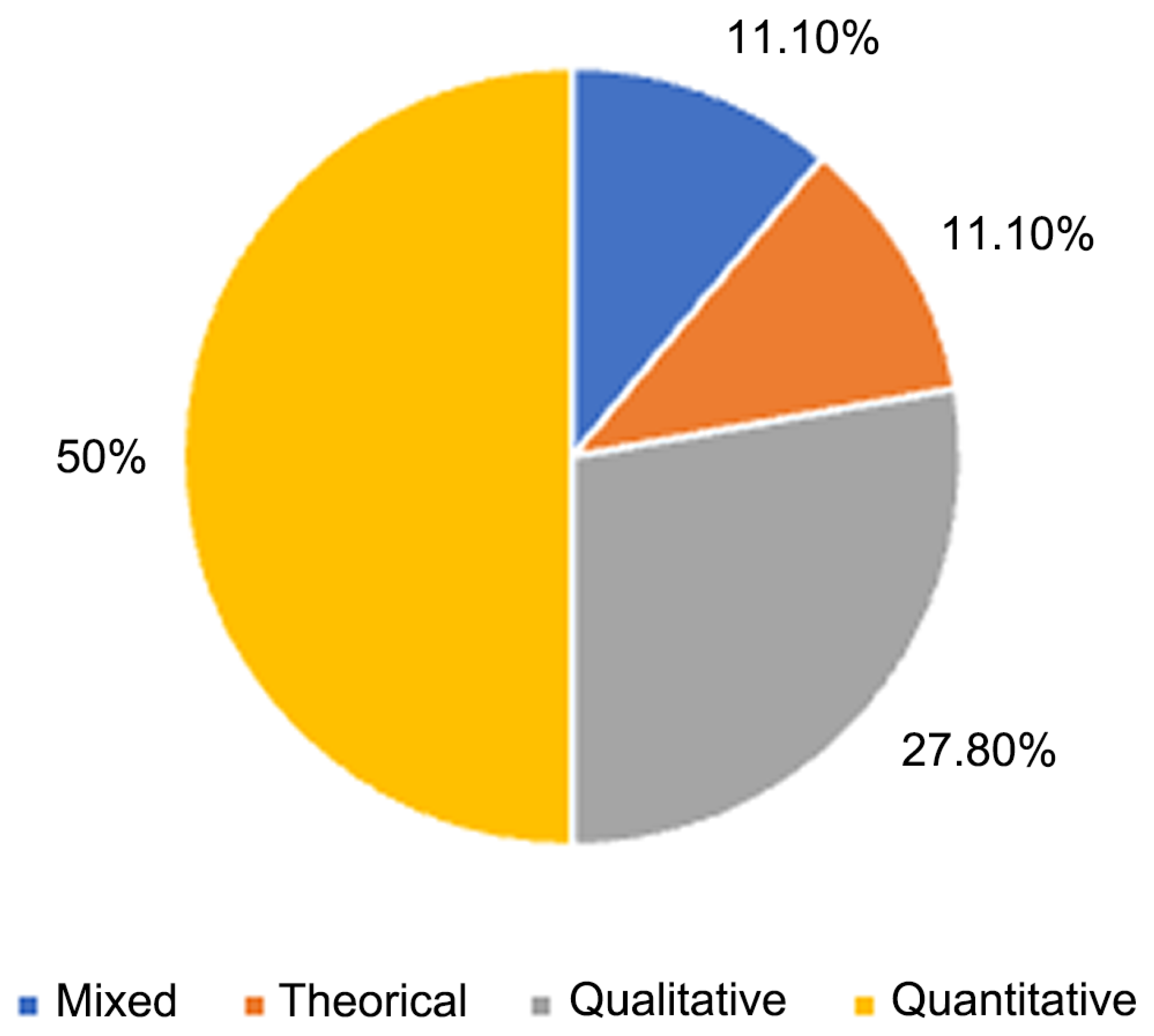
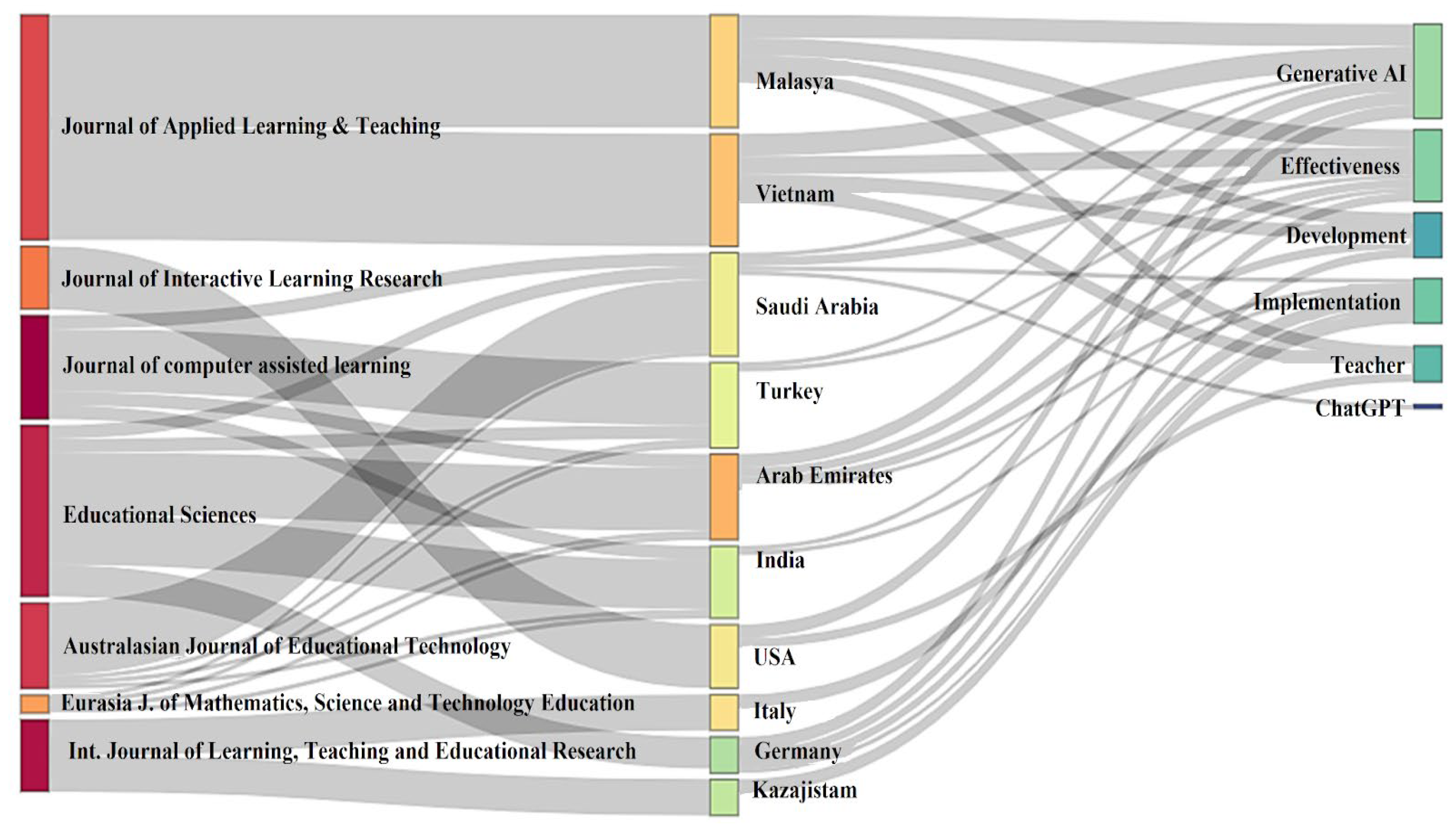
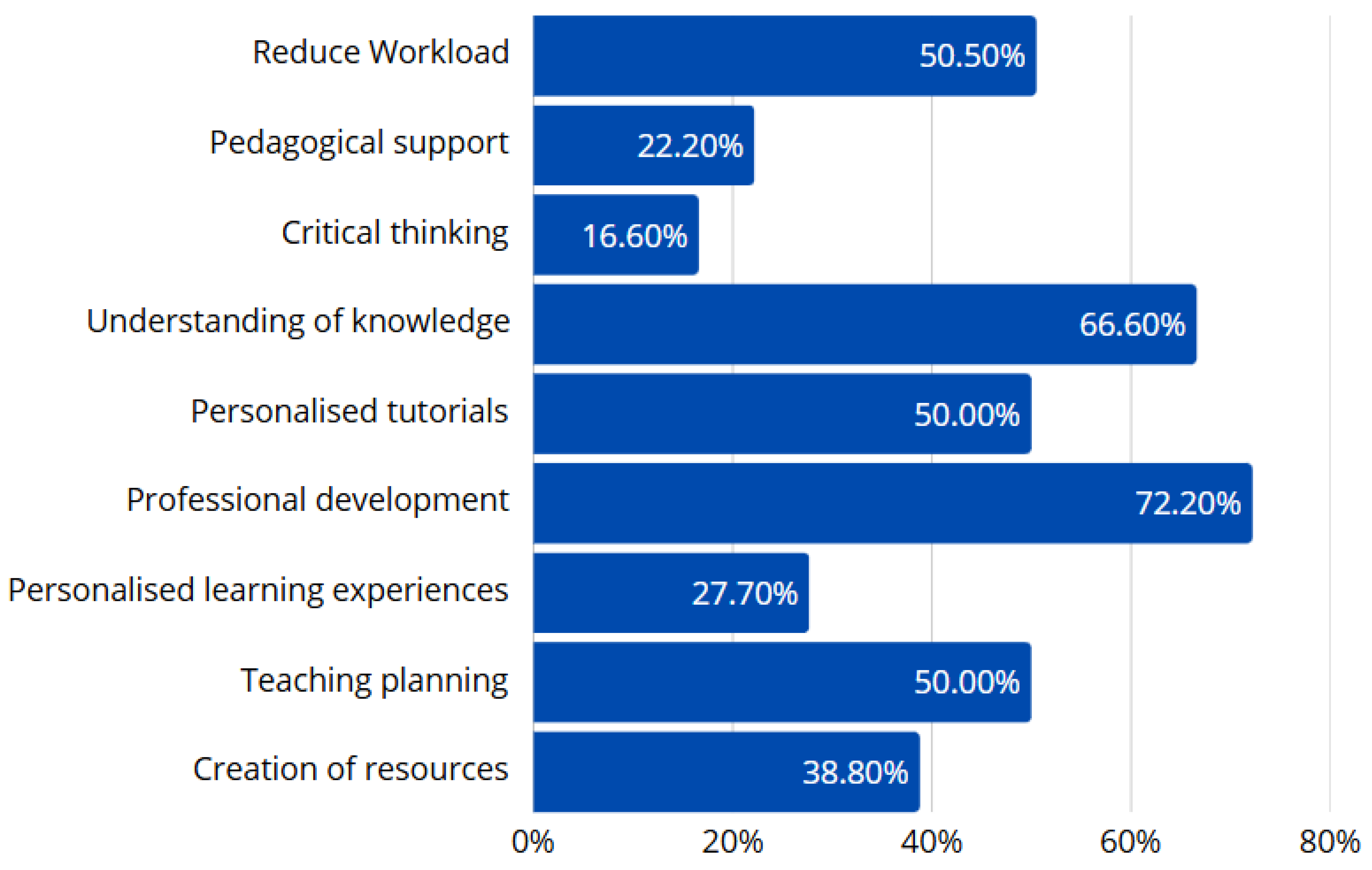
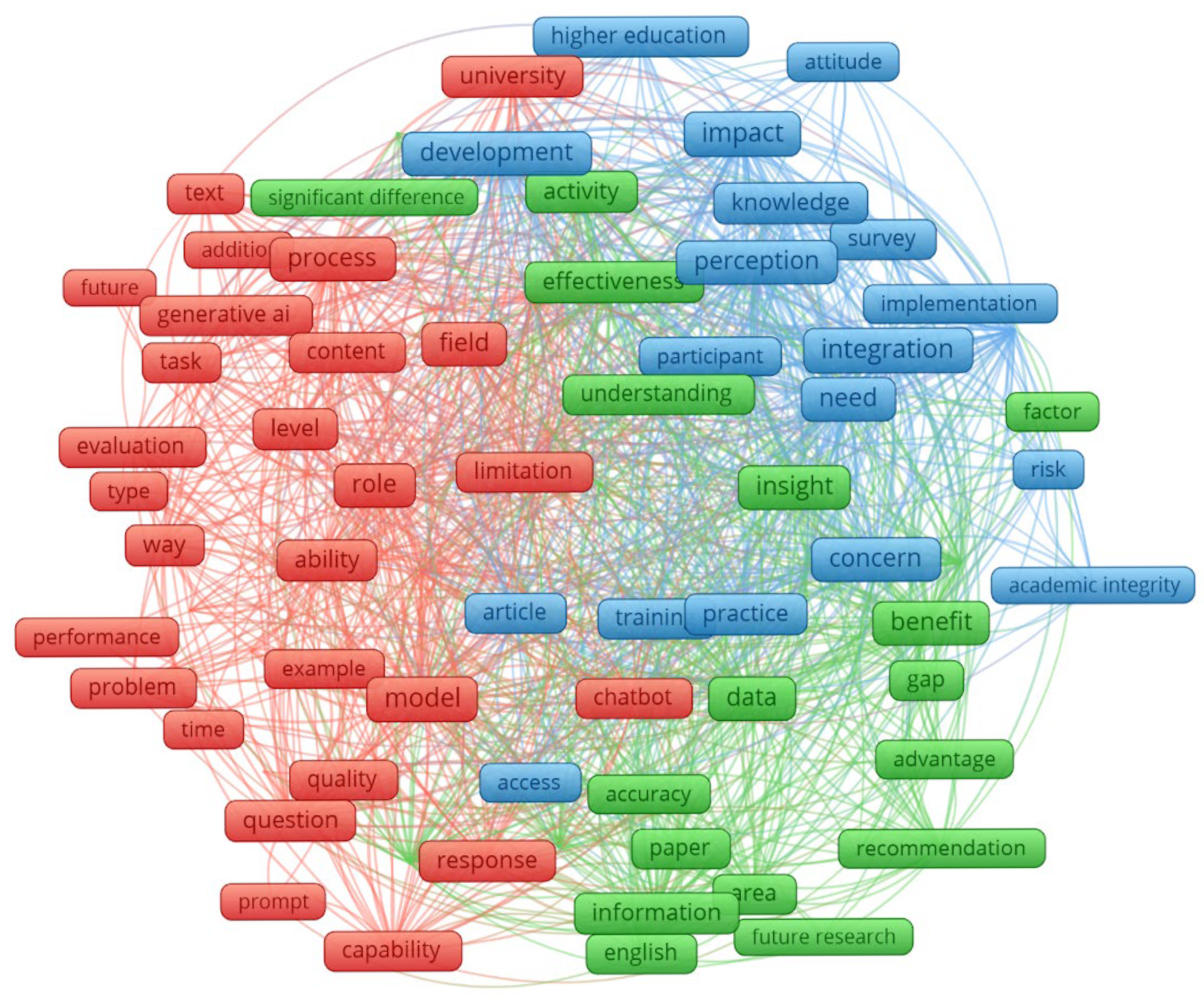
| Items | Yes | No |
|---|---|---|
| Clarity in the formulation of the research problem: Is the formulation of the research problem clearly defined in the selected studies on the use of ChatGPT to transform teachers’ digital competence? | ✓ | X |
| Adequate study design to address the research questions: Is the study design adequate to address the research questions related to transforming teachers’ digital competence through ChatGPT? | ✓ | X |
| Reliability of data collection methods: Are the data collection methods used in the studies serve to evaluate the effectiveness of ChatGPT in teacher education reliable? | ✓ | X |
| Adequate data analysis: Does the data analysis conducted in the studies determine the impact of ChatGPT on teachers’ digital competence appropriate? | ✓ | X |
| Implementation of strategies to reduce bias: Do studies implement effective strategies to reduce bias in assessing the impact of ChatGPT on teacher transformation? | ✓ | X |
| Relevance and consistency of findings: Are the findings of the studies relevant and consistent with the objectives and results presented on the influence of ChatGPT on teachers’ digital competence? | ✓ | X |
| Authors | Country | Type of Study | Participants | Results/Implications | Limitations |
|---|---|---|---|---|---|
| Iqbal et al. [36] | Malaysia | Qualitative | University teaching staff | Most do not use it in the classroom, due to lack of training, but they are aware of its benefits. Teachers need to improve their training. | The study had a small sample size of only 20 participants, which restricts the generalisability of the results; it did not explore students’ perceptions of ChatGPT use in higher education, nor did it assess how this technology is being used in university teaching and learning. |
| Nguyen [37] | Vietnam | Mixed | University teaching staff | They are excited about its implementation in the classroom, but emphasise the need for more professional training. Benefits in creating learning resources and helps reduce their workload. | The sample was limited to 20 English teachers at a single university, which restricts the generalisability of the results; furthermore, although the participants were already using ChatGPT, they were still in the process of familiarising themselves with the tool, which limited the depth of their responses. |
| Ali et al. [38] | Saudi Arabia | Quantitative | University teaching staff | ChatGPT can help to improve students’ academic skills and encourage motivation and interest in the classroom. This requires adequate teacher training. | A limitation of the study was the absence of qualitative data that would have enriched the results. In addition, further quantitative and qualitative exploration of how ChatGPT influences new learning styles and strategies is needed. |
| Allehyani and Algamd [39] | Saudi Arabia | Quantitative | Early childhood teachers | There is a gap in TDC to apply AI. ChatGPT offers numerous pedagogical possibilities and enriches teaching practice. | The main limitation of the study is its exclusively quantitative approach, based on a self-administered questionnaire, which restricts the depth and richness of the findings on teachers’ perceptions. This methodology prevents us from capturing the complexity of implementing ChatGPT in teaching English as a second language. |
| Urazbayeva et al. [40] | Kazakhstan | Quantitative | University teaching staff | ChatGPT improves teachers’ AI literacy. It also offers benefits such as creative lesson planning, automated assessments and personalised learning experiences. | The sample was small and geographically limited, which restricts the generalisability of the results. In addition, the intervention was of short duration and did not include a control group, which precludes attributing the observed changes exclusively to the intervention. It also highlights the limitation of using ChatGPT due to its outdated database, which could lead to misinformation, especially in areas such as science. |
| Firat [41] | Turkey | Qualitative | University teaching staff | The integration of AI in education offers numerous opportunities to improve learning experiences, personalise teaching, reduce teacher workload and transform the role of educators. However, this shift poses challenges in terms of assessment, digital literacy, and ethical considerations. | The research was based on a small sample of 21 academics and Ph.D. students, and used a single open-ended question for data collection, which restricts the depth and diversity of responses. In addition, all participants were assumed to have a good understanding of English, which may not be representative of wider contexts. |
| Kaplan-Rakowski et al. [42] | USA | Quantitative | Primary education teaching staff | Teachers express positive perspectives towards the integration of AI into their teaching practice. The more they used it, the more positive their perspectives became. Teachers believe that AI can enhance their professional development and can be a valuable tool for students. | Although the study includes a variety of teachers from different contexts, the sample size is relatively small, which limits the generalisability of the results to the whole population of teachers. |
| Al-Mughairi and Bhaskar [43] | Oman | Qualitative | University teaching staff | Teachers use ChatGPT to explore innovative educational technologies, personalise their teaching practice, save time, and for professional development. However, they are concerned about reliability, reduced human interaction, privacy, lack of institutional support, and over-reliance on ChatGPT. | The sample was limited to 36 teachers from the 10 UTAS sites in Oman, which restricts the generalisability of the findings to other cultural or educational contexts. Furthermore, by employing a qualitative approach based on interpretative phenomenological analysis (IPA), an in-depth but not necessarily representative understanding of all possible experiences was obtained. |
| Gladstone [44] | India | Theoretical | Does not specify level of education | It is a valuable tool for teachers that allows them to create content tailored to the needs of students, as well as being used as a virtual assistant that facilitates autonomous learning and personalised tutoring. | Although the study considers the diversity of the sample from different contexts, the small sample size limits the possibility of extrapolating the results to the whole population. |
| Mondal et al. [45] | India | Theoretical | Does not specify level of education | ChatGPT can serve as a personalised tutor that helps students improve their understanding of the topics covered in class. On the other hand, it has the potential to ease the workload of teachers, helping them focus on more complex aspects of the educational process. | The study was based on the free version of the model, which may have restricted some of its advanced capabilities and more precise functions. On the other hand, the examples used in the study were based on the authors’ personal experiences, without empirical or controlled validation in real educational contexts. |
| Kayali et al. [46] | Turkey | Quantitative | Higher education | This tool is mainly used as a teaching and learning assistant to improve the teaching and learning process of students. | A convenience sampling method was used, with 84 students. ChatGPT had difficulties understanding ambiguous questions, answering long questions correctly or handling unclear conversational situations. |
| Rahim et al. [47] | Malaysia | Quantitative | Higher education | The use of AI in classrooms is used for language learning, especially improving their writing skills and facilitating greater motivation to learn the language they are studying. | The sample was small and limited to a single university in Malaysia, which restricts the generalisability of the results; convenience sampling was used, which may introduce bias; only student perceptions were analysed without measuring actual improvements in language skills. |
| Bitzenbauer [48] | Germany | Quantitative | Secondary education | One study found that it has been used to foster critical thinking skills, especially in subjects such as physics, where students can interact with the chatbot to solve problems and clarify complex concepts. | The study consisted of only two class sessions, which is insufficient to assess sustainable impacts on the development of students’ critical thinking. The study focused on analysing students’ opinions about ChatGPT, without directly measuring skills such as critical thinking or conceptual learning. |
| Estrellado and Millar [49] | Philippines | Qualitative | Secondary education | This AI provides pedagogical support, helping teachers to personalise teaching and tailor assessments to the individual needs of students. | Exclusive use of an interpretive approach based on textual analysis, reliance on personal experiences that hinder comparisons and generalisations, and a small sample size that limits the applicability and replicability of the findings. However, it is noted that these limitations do not affect the validity of the study, as rigorous standards of qualitative research were followed. |
| Murgia et al. [50] | Italy | Quantitative | Primary education teaching staff | Teachers use ChatGPT with their students to better understand educational content through responses tailored to their literacy level. | A limitation of the study was the small size of the children’s sample and the use of a paper and a pencil to complete the task. It is proposed that digital devices will be used in future research, as there are differences in readability between printed and digital texts in primary education. |
| El Sayary [14] | United Arab Emirates | Mixed | Secondary education | Teachers’ perceptions are focused on lesson planning, teaching and learning, and to a lesser extent on assessment and feedback. This results in greater engagement on the part of students. | The sample was 40 participants from public schools in Dubai, preventing a larger sample size. |
| Wardat [51] | United Arab Emirates | Qualitative | Secondary education | In mathematics education, ChatGPT has been valued as a tool that can improve educational success by providing detailed instructions and assistance in complex topics such as geometry. | The sample was small and focused on early adopters, which limits the generalisability of the findings. In addition, the exclusively qualitative approach lacks quantitative support to objectively measure the impact of ChatGPT. Errors in the mathematical reasoning of the model were also identified, especially in topics such as geometry and limits, which is evidence of a lack of conceptual understanding. |
| Nguyen [52] | Vietnam | Quantitative | University teaching staff | The participating teachers had little knowledge of ChatGPT. The results indicate the need for adequate training or guidance in the use of ChatGPT, and to be able to implement ChatGPT in teaching and assessment. | The study was based on a limited sample of 43 university teachers, which restricts the generalisability of the results. Furthermore, although open-ended questions were used, the data collected lacked depth in terms of teachers’ specific beliefs and experiences. Finally, it points to the need for future mixed-methods research to provide a more complete picture of the use of this tool in educational contexts. |
Disclaimer/Publisher’s Note: The statements, opinions and data contained in all publications are solely those of the individual author(s) and contributor(s) and not of MDPI and/or the editor(s). MDPI and/or the editor(s) disclaim responsibility for any injury to people or property resulting from any ideas, methods, instructions or products referred to in the content. |
© 2025 by the authors. Licensee MDPI, Basel, Switzerland. This article is an open access article distributed under the terms and conditions of the Creative Commons Attribution (CC BY) license (https://creativecommons.org/licenses/by/4.0/).
Share and Cite
Fernández Cerero, J.; Montenegro Rueda, M.; Román Graván, P.; Fernández Batanero, J.M. ChatGPT as a Digital Tool in the Transformation of Digital Teaching Competence: A Systematic Review. Technologies 2025, 13, 205. https://doi.org/10.3390/technologies13050205
Fernández Cerero J, Montenegro Rueda M, Román Graván P, Fernández Batanero JM. ChatGPT as a Digital Tool in the Transformation of Digital Teaching Competence: A Systematic Review. Technologies. 2025; 13(5):205. https://doi.org/10.3390/technologies13050205
Chicago/Turabian StyleFernández Cerero, José, Marta Montenegro Rueda, Pedro Román Graván, and José María Fernández Batanero. 2025. "ChatGPT as a Digital Tool in the Transformation of Digital Teaching Competence: A Systematic Review" Technologies 13, no. 5: 205. https://doi.org/10.3390/technologies13050205
APA StyleFernández Cerero, J., Montenegro Rueda, M., Román Graván, P., & Fernández Batanero, J. M. (2025). ChatGPT as a Digital Tool in the Transformation of Digital Teaching Competence: A Systematic Review. Technologies, 13(5), 205. https://doi.org/10.3390/technologies13050205








